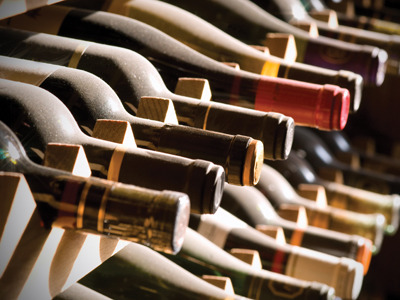I have these incredible dreams. I walk down a set of wooden stairs to a massive polished wooden door with a large iron lock on it. I and I alone have the key to the treasures that lay within. I unlock the door and behold a large, dark, cool room filled with dusty bottles of wine stacked up tall on all four walls with dim candlelight flickering all around them. I have no idea what is inside, but whenever I need or want something, the perfect bottle magically appears; wine for casual evening sipping, choice vintages for mealtime entertaining and aperitifs for late evening nightcaps. But, then I wake up, shake my head and run downstairs to the empty bowels of my own basement ““ alas, there is no massive polished wooden door to be found, just a small corner of mismatched wine racks and half empty wine cases turned on their sides. And I don't know what's down there either, so it's no wonder the perfect wine doesn't magically appear when my desire strikes.
So I pull back my shoulders and I decide its up to me to manage my wine cellar. It's a daunting task because, well, wine costs a lot of money! So I've decided to consider that stocking a wine cellar is very much like starting an investment fund. It's hard to start, but once started, it makes a lot of other things possible. So I begin.
First, I need some wines for aging. Many reds need anywhere from a few years to several decades to achieve their mellow, multifaceted maturity and it only makes sense to buy them young. Older wines are almost impossible to find and if you could find them, you wouldn't be able to afford them.
I always buy four bottles of each wine. This way I can measure its development along the aging process. Open them six months apart, take detailed notes when you taste them and store the notes with the next bottle to be opened. After each tasting, read the previous notes and you'll get a good sense of how the wine is aging. This process also helps your own tasting and wine preferences to mature along with your wines.
Long term cellaring for red wines is not the only reason for a wine cellar. Most of the wine in your cellar should be for drinking, not aging, especially in your first year of enjoyment. You'll need to stock wine for personal drinking, immediate drinking, wines to dine with and wines to marry with foods.
Consider stocking drinkable reds such as a few juicy, black cherry, beef and roasted herb flavoured Syrahs for barbecue season or perhaps a full Italian Barbara for cool weather alongside roasted savoury meats. A few crisp bottles of Niagara Rosé for refreshing summertime sipping; full bodied, creamy Chablis or searing New Zealand Sauvignon Blancs for dining excitement; Niagara sparkling wines for drinking whenever the mood strikes and Champagne for decadent moments.
Never forget to stock a few dessert wines to make the end of a meal spectacular or fortified wines for hearty winter sipping. Don't overlook half bottles and magnums. You'll find magnums age more slowly and many would say, more evenly. Also, serving a magnum at a dinner party makes the event much more special and festive.
To keep your cellar growing you should set a monthly budget for wine purchases and stick to it. Plan your monthly purchases in two groups. A little more than one half of the wines should be for everyday drinking and the rest for aging.
White wines should always be drunk young, except perhaps for some Chardonnays and sweet dessert wines. Unless you're a white wine lover, a good rule of thumb for stocking a cellar is three reds for every one white.
As you get into wine cellaring, your tastes will change and evolve. Make sure your cellar has room for new discoveries, new regions and new styles of wine and don't stock your cellar too heavily in any particular region. Don't forget to replace bottles, adding to your cellar as wines are consumed and if you're wondering what wines you should buy, take a look at wine magazines for a start.
My incredible dream is closer to becoming a reality since my wine cellar is now in order. Recently I served a 20-year-old Borgogna Barolo and it was perfectly aged; luscious, and velvet, we swooned over every sip. We enjoyed it with a savoury Piedmontese eggplant timbalo. A marriage made in heaven! I checked my notes and found I bought it over a decade ago for only $45. I wonder how much it would retail for today, if I could even find it! This is when a wine cellar starts to pay for itself in dollars and cents.
Red Wines for Aging
The information in brackets is the LCBO order number.
Corte Majoli 06 Amarone,
$32.95 (81943)
Caparzo 04 Brunello di Montalcino,
$43.95 (579094)
Pillitteri 06 Cabernet Sauvignon Reserve,
$38 (winery)
Fog Dog 07 Pinot Noir,
Sonoma, $49.95 (128256)
Red Wines for Drinking
Emiliana Natura 09 Cabernet Sauvignon,
$15.95 (61069)
La Posta Pizzella 08 Malbec,
Argentina $15 (166298)
Leopard's Leap 09 Sauvignon Blanc,
South Africa $12.95 (203356)
Clos du Bois Zinfandel 07 North Coast,
$19,95 (942599)
White Wines for Aging
Trumpour's Mill 08 Chardonnay,
Prince Edward County $14.95 (111955)
Fog Crest Chardonnay 06,
Russian River Valley, $47.95 (211292)
Chateau Guinaud 06,
AC Sauternes, 1er Cru, $38/375 mL (563510)
Ziraldo Riesling Icewine,
VQA, $59/375 mL (www.ziraldo.ca)
White Wines for Drinking
Chateau de Ligny Chablis 08,
AC, $18.95 (20015)
Cline 09 Viognier,
North Coast, $14.95 (128421)
3 Stones 09 Sauvignon Blanc,
New Zealand $12.95 (207159)
Stratus 08 Riesling,
Niagara $29.20 (131011)
Port and Dessert Selections
Port: Portal Coheita 07,
DOC Douro, $16.95 (190769)
Austraian Sticky: de Bortoli Noble One 07 Botrytis Semillon,
$29.95/375 mL (917252)
